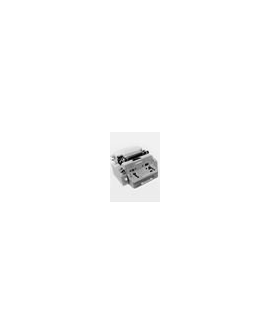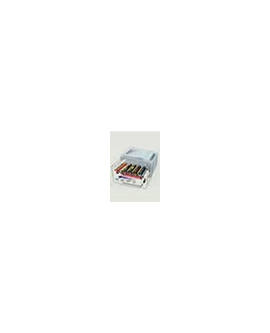The 130th Anniversary column

130 years on the leading edge
The progressive spirit OKI inherited from its founder Kibataro Oki remains alive to this day.
On November 1, 2011, OKI marked 130 years of contributing to the development of information and telecommunications technologies since its founding in 1881 as Japan's first electronic telecommunications device manufacturer. This column introduces historical episodes that show "Progressive Spirit", which is the driver of OKI's businesses. There will be a total of 20 episodes, starting April 2011 until March 2012.
-

Part 1
Part 1: The challenge of founder Kibataro Oki
This column introduces the course of events through which founder Kibataro Oki, based on his conviction in his own skills and foresight, tackled the challenge of realizing his visions amid the turbulence and dramatic changes of the Meiji Era to found Meikosha, Ltd., OKI's predecessor.
(Posted May 17, 2011) -

Part 2
Part 2: OKI's Founding and Business Expansion
In 1881, Kibataro Oki had founded Meikosha, Ltd., an event that could be described as the dawn of Japan's telecommunications industry. The company embodied his foresight and challenging spirit—in short, his entrepreneurial spirit.
(Posted June 1, 2011) -

Part 3
Part 3: The first steps to becoming a modern manufacturer
Seeking to begin domestic production of automatic telephone exchanges, Oki entered into a technological partnership with a British firm. The resulting efforts to manufacture automatic exchanges put OKI on the path to becoming a truly modern manufacturer.
(Posted June 1, 2011) -

Part 4
Part 4: A wartime economy
During wartime, much of OKI production was diverted by the military. At the same time, based on the conviction that the only path to survival lay in continued research and development and improvements in technological capabilities, OKI took great pains to accumulate technologies that would prove beneficial later.
(Posted June 15, 2011) -

Part 5
Part 5: Postwar efforts to restore the telephone infrastructure
Following the war, OKI sought to restore the country's devastated telephone infrastructure, playing a major role in developing the Type-4 Telephone, often said to be symbolize Japan's recovery.
(Posted July 1, 2011) -

Part 6
Part 6: Venturing into overseas markets with telephone technologies
With Japan entering an era of high growth, OKI opened a new chapter in its history as a general telecommunications manufacturer, venturing into overseas markets and winning an order for a telecommunications plant in Honduras.
(Posted July 15, 2011) -

Part 7
Part 7: Dominating world markets with OKI's millimeter-wave technologies
In the period of rapid economic growth, OKI evolved into a general manufacturer offering a wide range of products, including electronics. One milestone in this process was the development of millimeter-wave telecommunications technologies, including a millimeter-wave magnetron, an achievement that made OKI's millimeter-wave technologies world-famous.
(Posted August 16, 2011) -

Part 8
Part 8: Developing a teletype machine and gaining a reputation as a supplier of peripheral devices
Japan entered the age of computerization around 1955. OKI participated in a public/private joint venture toapan entered the age of computerization around 1955. OKI participated in a public/private joint venture to develop a Japanese computer and subsequently became a leader in this field, particularly in the area of peripheral (input/output) devices.
(Posted August 16, 2011) -

Part 9
Part 9: Providing core technologies to advance the development of an electronic switching system
In April 1967, Nippon Telegraph and Telephone Public Corporation announced the Ten-year Vision for Telegraphs and Telephones. Among the new core technologies required to achieve this vision, the proposed electronic switching system attracted significant attention. OKI played a pivotal role in the national project to develop this system.
(Posted September 1, 2011) -

Part 10
Part 10: Transferring the Production of Rotary Dial Telephones and Developing Push-button Telephones
OKI produced Type-600 dial telephones continually throughout the 1960s. However, with electronic technologies sweeping the field of telephony, OKI launched vigorous efforts to develop and produce push-button phones. It also chose to transfer the production of Type-600 telephones to another company. The last Type-600 telephone to roll off the line was the 3,908,706th unit manufactured.
(Posted September 15, 2011) -

Part 11
Part 11: Revision of the Public Telecommunications Law and Development of Thermal-type Facsimiles
In 1972, the revised Public Telecommunications Law opened telecommunications lines to allow the connection of terminal units. Against this backdrop, OKI announced a new facsimile machine for business applications to meet the emerging needs, helping to spur the rapid diffusion and development of facsimile machines.
(Posted October 4, 2011) -

Part 12
Part 12: Cash Dispensers (CDs) and Automated Teller Machines (ATMs)
In 1967, OKI received an order for an online system from Fuji Bank, which took a highly proactive approach to online networks. In the mid-1970s, OKI developed a new terminal system for Fuji Bank's second-generation online system. As a manufacturer whose name was synonymized with "terminals," OKI made full use of its expertise in developing cash dispensers (CDs) and automated teller machines (ATMs).
(Posted October 18, 2011) -

Part 13
Part 13: Successful Development of a CMOS IC—Becoming a Leading Manufacturer of IC for Watches
Transistors were eventually replaced by ICs (Integrated Circuits), each embedded with multiple circuit elements, which were commercialized in the late 1960s. In 1971, OKI developed an IC approved by NTT for use in its electronic switching systems. Furthermore, OKI strove to create innovations in the field of MOS-ICs, and opened up new markets.
(Posted November 1, 2011) -

Part 14
Part 14: Venturing into Optoelectronics with LED Printers
LEDs (light emitting diodes) have drawn attention for their energy-saving potential and as a technology for fighting global warming. OKI was among the pioneers in LEDs, beginning work in 1965 and developing the world's first page printer using an LED light source in 1981. It currently occupies a unique position in LED technologies, including LED color printers.
(Posted November 15, 2011) -

Part 15
Part 15: Development of the ATM Series and Its Ensuing Evolution and Revolution
Soon after delivering online cash dispensers to Fuji Bank in 1970, OKI succeeded in developing the world's first cash recycling ATM (Automatic Teller Machine), thereby establishing its ATM business as a major business pillar. In 2009, OKI introduced a new cash recycling ATM capable of handling banknotes from multiple countries. OKI continues to develop ATMs based on a global perspective.
(Posted December 1, 2011) -

Part 16
Part 16: A New Idea from the OA Business Division: The Kawaraban Electronic Whiteboard
OKI made a full-fledged entry into the office automation business under Part II of the management reform plan, announced in 1982. While the business presented a difficult struggle at first, the introduction in December 1983 of the Kawaraban electronic whiteboard, capable of printing text and diagrams written on a whiteboard resulted, in major progress.
(Posted December 15, 2011) -

Part 17
Part 17: The Trajectory of the Market-Leading Call Center System
Call centers serve as important points of contact between businesses and their customers. Moving forward to tackle the challenge of multimedia technologies, OKI developed the CTstage call center system in 1996. This feature traces the history of CTstage, which has grown to capture the leading market share today.
(Posted January 17, 2012) -

Part 18
Part 18: The Development of OKI Networkers, a Home-Based Employment System for People with Major Disabilities
Company efforts in the domain of corporate social responsibility (CSR) are highly valued these days. In 1996, OKI established its Social Contribution Promotion Office. The efforts by this section—to harness computer networking technologies to enable work from home for individuals who would otherwise face great difficulty in commuting to and from work due to major disabilities and employ them—have drawn considerable attention. This feature introduces the story underlying these activities and their growth trajectory.
(Posted February 1, 2012) -

Part 19
Part 19: Contributions to Airport Security and Aviation Safety
Since the 1990s, in response to globalization, OKI has developed automated gate systems that improve the efficiency of airport immigration inspections. As part of an initiative to improve security still further, OKI is developing a next-generation automated gate system based on biometric authentication technologies. This feature discusses OKI's airport-related business.
(Posted February 17, 2012) -

Part 20
Part 20: Moving beyond the 130th anniversary as part of OKI's second founding
Since its founding in 1881 as Japan's first electronic telecommunications device manufacturer, OKI's achievements have provided key support for society's vital infrastructures. This page describes OKI's enthusiasm for the future as it marks the 130th anniversary of its founding and takes new steps toward the future.
(Posted March 1, 2012)
